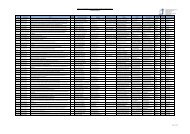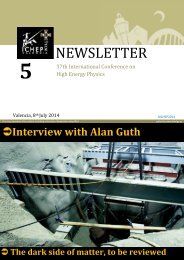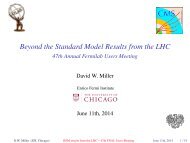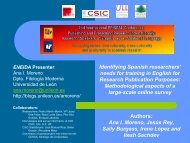PW_mar13_sample_issue
PW_mar13_sample_issue
PW_mar13_sample_issue
You also want an ePaper? Increase the reach of your titles
YUMPU automatically turns print PDFs into web optimized ePapers that Google loves.
physicsworld.com<br />
“Some of us should venture to embark on a synthesis<br />
of facts and theories, albeit with secondhand and<br />
incomplete knowledge of some of them – and at the<br />
risk of making fools of ourselves.”<br />
So said Erwin Schrödinger in 1943 upon his foray<br />
from quantum physics into genetics. He would soon<br />
back up these words with his hugely influential 1944<br />
book, What is Life?, in which he predicted that genetic<br />
information is stored within an aperiodic crystal – an<br />
idea that would be confirmed by Francis Crick and<br />
James Watson less than a decade later when they<br />
discovered the structure of the double helix. Today,<br />
a small but increasing number of us would echo<br />
Schrödinger’s sentiments, even though the case has<br />
yet to be made conclusively for a causal link between<br />
some of the weirder aspects of quantum mechanics<br />
and biology.<br />
It is certainly true that although many examples<br />
can be found in the literature dating back half a<br />
century, there is still no widespread acceptance<br />
that quantum mechanics – that baffling yet powerful<br />
theory of the subatomic world – might play a<br />
crucial role in biological processes. Of course, biology<br />
is, at its most basic, chemistry, and chemistry is<br />
built on the rules of quantum mechanics in the way<br />
atoms and molecules behave and fit together. But<br />
biologists have (until recently) been dismissive of the<br />
counterintuitive aspects of the theory – they feel it<br />
to be unnecessary, preferring their traditional balland-stick<br />
models of the molecular structures of life.<br />
Likewise, physicists have been reluctant to venture<br />
into the messy and complex world of the living cell.<br />
Why should they when they can test their theories<br />
far more cleanly in the controlled environment of<br />
the physics lab, where they at least feel they have a<br />
chance of understanding what is going on? But now,<br />
experimental techniques in biology have become so<br />
sophisticated that the time is ripe for testing a few<br />
ideas familiar to quantum physicists.<br />
Sticking together<br />
Of all the quantum processes suggested as playing a<br />
role in biology – which include quantum coherence,<br />
superposition and entanglement – one of the least<br />
contentious and best studied is quantum tunnelling.<br />
This is the mechanism whereby a subatomic particle,<br />
such as an electron, proton or even a larger atomic<br />
nucleus, does not have enough energy to punch<br />
through a potential barrier (essentially a force field),<br />
but instead behaves as a spread-out fuzzy entity that<br />
can leak through the barrier and so occasionally find<br />
itself on the other side. This phenomenon is familiar<br />
in physics and is the mechanism responsible for radioactive<br />
decay and nuclear fusion. Quantum tunnelling<br />
is also well known in chemistry, for example in<br />
the form of hydrogen tunnelling in hydrogen-bonded<br />
dimer molecules, such as benzoic acid.<br />
It turns out that even in biology it is now well established<br />
that electrons quantum tunnel in enzymes,<br />
allowing certain chemical processes to speed up by<br />
several orders of magnitude. But one particular question<br />
that I, and others, have been exploring over the<br />
past few years is whether quantum tunnelling of hydrogen<br />
nuclei (protons) in the form of a hydrogen bond<br />
Quantum frontiers: Quantum biology<br />
has a role to play in one of the most important processes<br />
in molecular biology: DNA mutation. Hydrogen<br />
bonds are stronger than Van der Waals forces but<br />
weaker than ionic and covalent bonds, being a happy<br />
medium that hold certain organic molecules together.<br />
Crucially, they are strong enough to help build stable<br />
structures, but not so strong that they cannot be broken,<br />
which is why the structures can be rearranged<br />
into new configurations. The hydrogen bond is also<br />
responsible for stabilizing proteins and for modulating<br />
the speed and specificity of chemical reactions.<br />
In physical terms, the hydrogen bond can be<br />
described as a proton trapped in a double, often<br />
asymmetric, finite potential well. The two potential<br />
minima exist because the proton is happiest being<br />
close to one or other of the two atoms at each end of<br />
the bond, with an energy barrier in the middle, which<br />
the proton can only get over classically if given sufficient<br />
energy. To understand the proton’s behaviour<br />
we need to map the shape of this well, or potential<br />
energy surface, very accurately. This is no trivial matter<br />
as its shape depends on many variables. Not only<br />
is the bond typically part of a large complex structure<br />
consisting of hundreds or even thousands of atoms,<br />
it is also usually immersed in a warm bath of water<br />
molecules and other chemicals. Moreover, molecular<br />
vibrations, thermal fluctuations, chemical reactions<br />
initiated by enzymes and even UV or ionizing radiation<br />
can all affect the behaviour of the bond both<br />
directly and indirectly. In addition to all this, and<br />
what is of most interest here, is that the small mass<br />
of the proton means it is able to behave quantummechanically<br />
and very occasionally tunnel through<br />
the potential barrier from one well to the other (see<br />
for example the 2011 paper by Angelos Michaelides<br />
and colleagues at University College London – Proc.<br />
Natl Acad. Sci. 108 6369).<br />
This discussion is certainly relevant to DNA, which<br />
consists of two nucleotide chains wrapped around<br />
each other in a double helix. They are held together<br />
and stabilized by hydrogen bonds, which link the base<br />
pairs: adenine to thymine (A–T) and cytosine to guanine<br />
(C–G). If we consider the A–T base pair, which<br />
is held together by two hydrogen bonds, then as a<br />
result of the different possible positions of the hydrogen<br />
atoms that form the bonds, two different structures<br />
are possible. Normally, the protons form what is<br />
called the canonical (keto) structure of the base pair<br />
(figure 1), but occasionally they can be found shifted<br />
across to the opposite sides of the hydrogen bonds to<br />
form the rare tautomeric (enol) form.<br />
After their landmark paper, which was published<br />
60 years ago next month, Watson and Crick’s interests<br />
quickly turned to the biological implications of<br />
the double-helix structure and in a follow-up paper<br />
of 1953 they suggested that spontaneous mutation – a<br />
change in the genetic code, for example from ATCAT<br />
to ATCAC – may be caused by a base taking on its<br />
higher-energy, rarer, tautomeric form. A decade<br />
later, the Swedish physicist Per-Olov Löwdin boldly<br />
proposed that the tautomeric base pair that leads to<br />
a mutation is formed through double proton transfer,<br />
with each particle quantum tunnelling through the<br />
barrier separating the two asymmetric potential wells<br />
Jim Al-Khalili is a<br />
theoretical nuclear<br />
physicist and holds a<br />
chair in public<br />
engagement in<br />
science at the<br />
University of Surrey,<br />
UK. He is also a<br />
broadcaster and<br />
author whose latest<br />
book is Paradox:<br />
the Nine Greatest<br />
Enigmas in Physics<br />
published by Bantam<br />
Press, e-mail<br />
j.al-khalili@<br />
surrey.ac.uk<br />
Physics World March 2013 43








